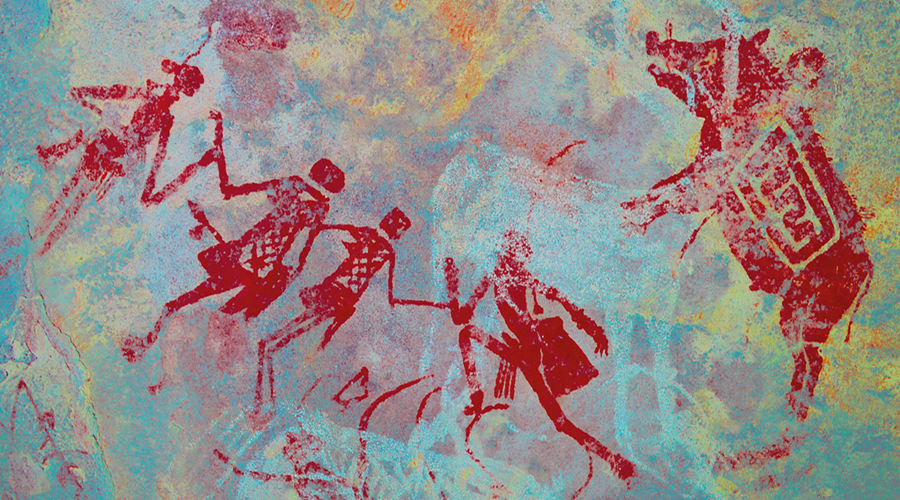



The Institut Francais in London witnessed an intriguing and illuminating afternoon with the Rock Art Seminar and screening of Werner Herzog's film 'The Cave of Forgotten Dreams'. The Rock Art Seminar was initiated and chaired by Dr Didier Bouakaze-Khan, the rock art specialist from University College London, who presented the historical perspective of prehistoric research, beginning with its initial acknowledgement and tracing the course of significant discoveries which were to give rise to a number of theories concerning rock art to the present day.
Concerning one of the most important recent discoveries, it was very fitting for Dr Didier Bouakaze-Khan to then hand over to Professor Jean-Michel Geneste, Scientific director of the Chauvet Cave and Curator of the Lascaux Cave, and the PhD student Julien Monney, who together presented the rock art of Chauvet cave within the context of Europe, then France itself, and then finally to the area surrounding the rivers Ardeche and Rhone in the Ardeche region.
The prehistory of the area reveals that Chauvet is not an isolated case, as numerous sites display a wide range of rock art types - symbols, hand motifs, paintings only , engravings only, panels of art, and solitary art. The database reveals the engravings are close to the river, whilst the paintings are further away. There is greater archaeological evidence closer to the river. But without doubt, Chauvet is the jewel in the crown, and the proximity of the striking Pont D'Arc natural feature with that of the cave is surely no coincidence.
All 11,000 square meters of the cave topography have been mapped with 3D laser technology. The art of the cave has been precisely superimposed onto this topography in a way that perhaps only French scientists can. The scientific investigation, constantly constrained by the presence of only 12 researchers inside at a time, is thorough. It begins with the geology and geomorphology, exploring 'how' the cave was used. The palaeontology explores how the prehistoric fauna - cave bears, lions, bison, horses, wolves - related to human presence.
Note: the skull of a cave bear is over half a meter in length.
Research of the lithic tools shows what people were doing in the cave - cutting, engraving - as well as where they had come from. This also relates to the chronology of occupation, of both humans and animals. An early Solutrean hypothesis was quickly swept aside by the C14 results, revealing a much earlier Aurignacian occupation, for both paintings and animals. The inevitable controversy resulted in further C14 analysis in several laboratories, but the unanimous results confirmed the antiquity, and refined the dates to two major periods of occupation; the Aurignacian period, around 31 to 32 thousand years ago, and the Gravettian period, around 25 to 26 thousand years ago.
Note: Consider the time scale involved here, and the chasm between the two major occupations; it is an artistic legacy which represents an overall belief system that persisted with little change for over twenty millennia, ending only when the Ice Age finally drew to a close.
Further proof was appearing from the archaeological excavations and the analysis of stalagmites, as well as the carbonate deposits on the bear skulls upon the cave floor. All of the various results were revealing the stages of occupation.
However, the rock art of Chauvet is inscrutable. Both Jean-Michel Geneste and Julien Monney spoke of how the art seemed to change each time it was studied. Moreover, they described the dangers of interpretation; what we see is not necessarily what our Palaeolithic ancestors saw. Was the lion representational or was it conceptual? Functionality - how the images were used as a social product - and intentionality - the chosen canvas and style - are also called into question. In other words, no matter how much scientific analysis is applied to this material, the subjective perspective can never be entirely removed from the exercise.
And so to the film. Introducing 'The Cave of Forgotten Dreams', Jean-Michel Geneste stated simply "This is not science". It was my second viewing of Herzog's film of the famous cave, and his preliminary remark did indeed temper my reaction. But upon reflection, Chauvet is not just about 'science'; it is also about 'magic'. Whilst the film carries Herzog's customary trademark and represents his own personal take on the subject, he does succeed in conjuring the magical mystery of a very solemn place that still poses more questions than answers. This is why the afternoon at the Institut Francais was so rewarding; following the scientific investigation conveyed in the Seminar, the film allowed the imagination to soar, which is surely what the original artists within the cave hoped to achieve.
by Bradshaw Foundation
Monday 30 May 2022
by Bradshaw Foundation
Wednesday 19 January 2022
by Bradshaw Foundation
Thursday 06 January 2022
by Bradshaw Foundation
Monday 06 December 2021
by Bradshaw Foundation
Monday 29 November 2021
by Bradshaw Foundation
Monday 25 October 2021
by Bradshaw Foundation
Monday 12 July 2021
by Bradshaw Foundation
Monday 24 May 2021
by Bradshaw Foundation
Tuesday 20 April 2021
by Bradshaw Foundation
Thursday 01 April 2021
by Bradshaw Foundation
Tuesday 23 February 2021
by Bradshaw Foundation
Thursday 14 January 2021
by Bradshaw Foundation
Friday 18 December 2020
by Bradshaw Foundation
Sunday 06 December 2020
by Bradshaw Foundation
Thursday 26 November 2020
by Bradshaw Foundation
Wednesday 07 October 2020
by Bradshaw Foundation
Monday 30 May 2022
by Bradshaw Foundation
Wednesday 19 January 2022
by Bradshaw Foundation
Thursday 06 January 2022
by Bradshaw Foundation
Monday 06 December 2021
by Bradshaw Foundation
Monday 29 November 2021
by Bradshaw Foundation
Monday 25 October 2021
by Bradshaw Foundation
Monday 12 July 2021
by Bradshaw Foundation
Monday 24 May 2021
by Bradshaw Foundation
Tuesday 20 April 2021
by Bradshaw Foundation
Thursday 01 April 2021
by Bradshaw Foundation
Tuesday 23 February 2021
by Bradshaw Foundation
Thursday 14 January 2021
by Bradshaw Foundation
Friday 18 December 2020
by Bradshaw Foundation
Sunday 06 December 2020
by Bradshaw Foundation
Thursday 26 November 2020
by Bradshaw Foundation
Wednesday 07 October 2020
Friend of the Foundation











